Meet Dr. George Schaller
First published in Sanctuary Asia,
Vol. 26
No. 7,
July 2006
He has spent almost 50 years in the wilds of Asia, Africa, and South America, and has studied and helped protect the tiger, the lion, the giant panda, the mountain gorilla and the wild sheep and goats of the Himalaya. His 15 books include The Deer and the Tiger, The Year of the Gorilla, The Last Panda and Tibets Hidden Wilderness. One of the world's most passionate and committed advocates for conservation and considered by many to be the father of modern field biology, Dr. George Schaller, Vice President, Science and Exploration Progamme, Wildlife Conservation Society speaks to Jennifer Scarlott, Director, International Conservation Initiatives with Sanctuary magazine about science, conservation and mission.
Dr. George Schaller has spent a lifetime studying and working to conserve wildlife and wild habitats around the globe. He believes that each of us must take responsibility for the environment, since we all affect the planet in every action we take.
What led you to dedicate your life to wildlife?
I think most people who become naturalists start as children. They like to be outdoors. As you grow older, you discover that you can make a living doing what you like to do anyway. You go into it because you have a sense of wonder and you like to be with animals. But as time goes on, you realise youve got to fight on behalf of the animals and habitat, or they will disappear. So then you spend time on conservation. Conservation has nothing to do with animals, it has to do with economics, with society, with politics. Suddenly you find most of your time is spent on things you dont really want to do because thats not how you started out. But in the end, the conservation is more important.
You studied gorillas in Central Africa in the late 50s. Until you wrote about them, gorillas were considered dangerous “brutes". What led you to study them?
I didn't have that perception to begin with. Nothing was really known about wild gorillas. I went to the University of Alaska as an undergraduate, and spent a lot of time in the tundra and the forest with caribou and bears. I knew that animals try to stay out of your way. If you go quietly near them, they come to accept your presence. Thats what I did with gorillas. I just went near them day after day, which was fairly easy because they form cohesive social groups. Soon, I knew them as individuals, both their faces and their behaviour, and I just sat and watched them.
In the early 60s, you went to India to study tigers?
That was in the Kanha National Park. It was wonderful because at that time there were hardly any visitors. My wife and I and our two small sons were there in a little bungalow in the forest. There were chital around, and barasingha, and tigers wandering past our hut. It was lovely. Again, I was dealing with individuals, because I knew all the tigers by the stripes on their faces. At that time, every Indian forest officer felt he wasn't someone until he shot a tiger. Indira Gandhi helped change that. She said that tigers are beautiful and must be protected and that took hold. It shows you that a leader can have a huge impact. India has been trying very hard to protect tigers. The only place where tiger numbers are actually increasing is the Russian Far East. But India still has options. It has plenty of reserves, it just needs to protect and manage them.
What can the Indian Government do about the poaching crisis?
Tigers face continual threats - the locals poison them, sell their bones for medicinal purposes to Asian market countries like China and Japan. Tibetans have more money and want to wear tiger and leopard skins to show status. I was in Lhasa in December 2005, and the shops were full of leopard and tiger skins. In 2003, the Chinese authorities discovered one shipment from India containing the parts of 32 tigers, 581 leopards and 778 otters. But the Dalai Lama has been speaking out forcefully against the use of animal products, and Tibetans have been burning skins. The Tibetans are doing it the right way, in that the social pressure is coming from within.
How do you weigh the dangers of poaching and the international trade in wildlife products against habitat loss?
It depends on what species you're talking about. The tiger is suffering from a lot of habitat loss. The Indian Parliament is considering a measure that would give each family living in forest areas several hectares of land of their own - the Draft Tribal Bill, 2005 (See Sanctuary Asia Vol. XXV No. 4). That land would then become private rather than forest land. That will be the end of most tiger habitat because the government will lose control over the forest. The threat to habitat is very important in India. The Tibetan antelope has no habitat problem; it has wide-open spaces. But antelope are shot by the tens of thousands, and then the wool gets smuggled to Kashmir where it's woven into shahtoosh shawls. An international effort is needed to reduce this trade.
You first went to China in 1980, and your efforts helped to establish the Changthang Nature Reserve?
A foreigner, a field biologist, doesnt establish anything, the government does. All we can do is get facts and present them and make suggestions. If governments think our ideas are reasonable, they may implement them. Chinas been very receptive. In some areas of the reserve, species numbers have risen, but the whole area is very large, and some spots are better protected than others. Good legal control and management are essential. There are people living in the reserve - nomads with livestock. There as anywhere else, you can never turn your back. You can never win in conservation, never, because things change, cultures change. Twenty-five years ago, the nomads lived in tents and rode horses. Now, most of them live in huts, have solar panels for electricity, and have motorcycles. That changes everything.
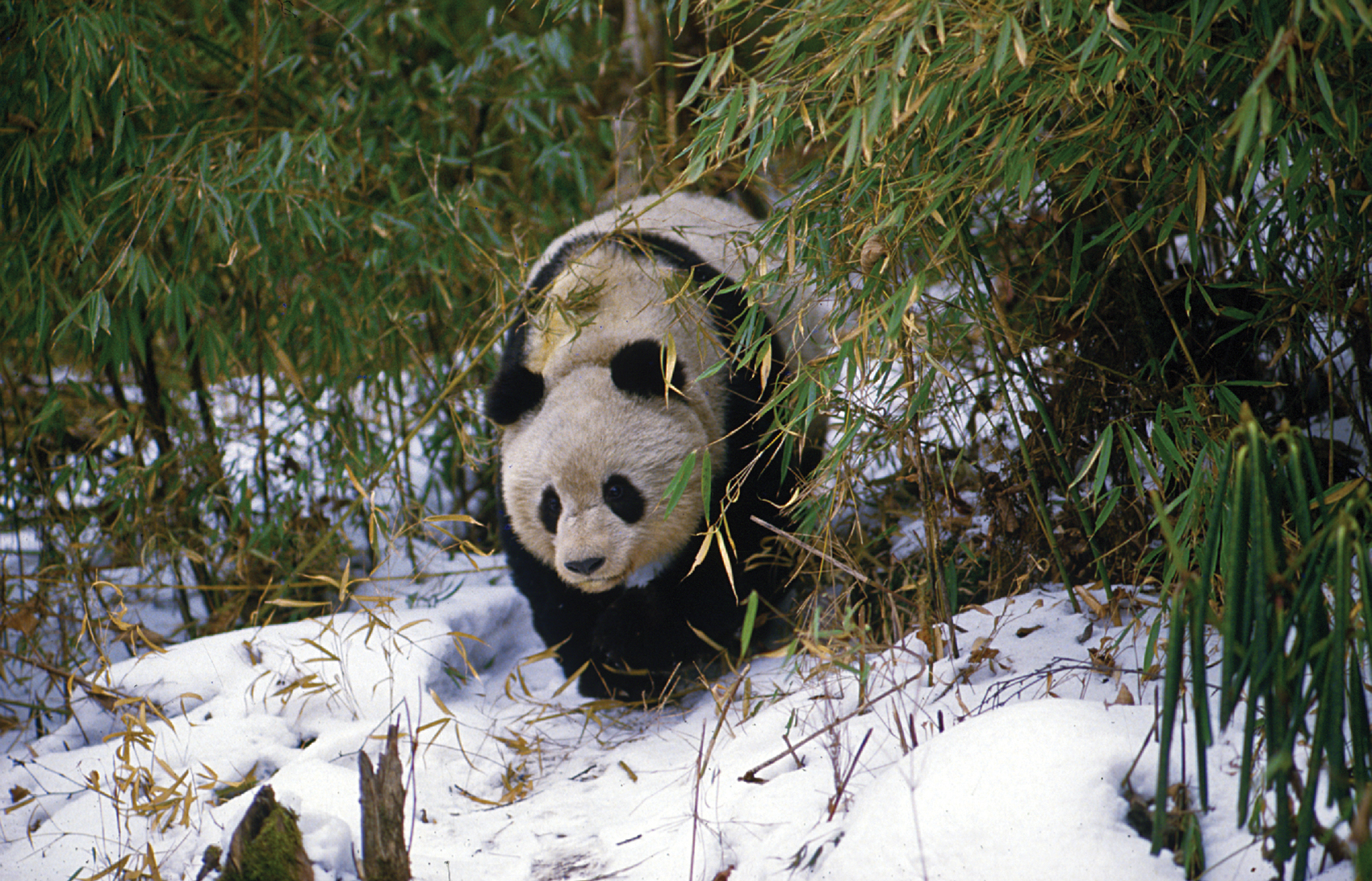
A giant female panda in the Wolong Reserve in China in 1982. Dr. Schaller first visited China in 1980 to radio collar and study giant panda behaviour. He worries that though the Chinese government has been receptive to the idea of protecting giant pandas, its ambitious economic objectives could end up destroying the natural resource base for wildlife.
The way that roads and guns changed everything in India for tigers and so many other animals?
Yes, and its the same in the U.S., you can never turn your back here. One of the things were fighting for continually is the Arctic National Wildlife Refuge. I was on the first expedition that made a biological survey of that area, as a result of which it was established in 1960. Thats nearly 50 years ago, and were still fighting to keep it. Huge amounts of effort, time and money go into the struggle. You would think something is safe in the U.S. once its established legally. But there is too much greed and politics. You have to continue the fight. That's true in every country.
The U.S. Endangered Species Act is under attack by the Bush administration?
This is what bothers me. Here is the richest country in the world. We cannot protect small areas without fighting for them constantly. Then you have one of the poorest countries, Rwanda, where we worked on gorillas. They've had genocide, civil wars - but they've saved the gorillas. They are one of the most crowded countries, yet, theyre proud of their gorillas. No matter who runs the government, they say, “we want to save the gorilla." Some species in the U.S. are doing well. This country is lucky, it has a lot of space and relatively low population density. I admire countries like India more - with over a billion people, it has still managed to save areas for wildlife. Its a continual battle for them, but they have a much better attitude toward animals than Americans do.
Where do you think that attitude comes from?
It has a religious basis. Buddhism, Hinduism, neither one encourages the killing of animals, whereas in America, they forget their education. Young school children like animals. But most kids forget those interests when they become teenagers. By the time most people in America are working adults, the environment has become very peripheral. How can people learn to hold onto their sympathy for and early interest in animals? Universities don't do it. We've had two people named Bush come out of Yale University. Both of them have been ecological illiterates. There's no excuse for universities not to teach students about the environment no matter what his or her future profession is. Our quality of life depends upon it. You cant eradicate poverty in a country with a destroyed environment. The U.S. uses up so much of the worlds resources. India and China are growing economically - there's going to be a real crunch for resources.
How do you respond to the continually resurfacing argument that all of the attention lavished on megafauna like tigers and pandas detracts from the needs of other animals?
People respond to animals emotionally. They're willing to give funds to help save tigers and pandas because they feel theyre beautiful. Of course, everything is beautiful in its own way, but people are not going to give a lot of money to preserve leeches and tsetse flies. But since tigers and pandas need so much space, they protect millions of other species within their habitats. The money that goes to them, helps all the animals.
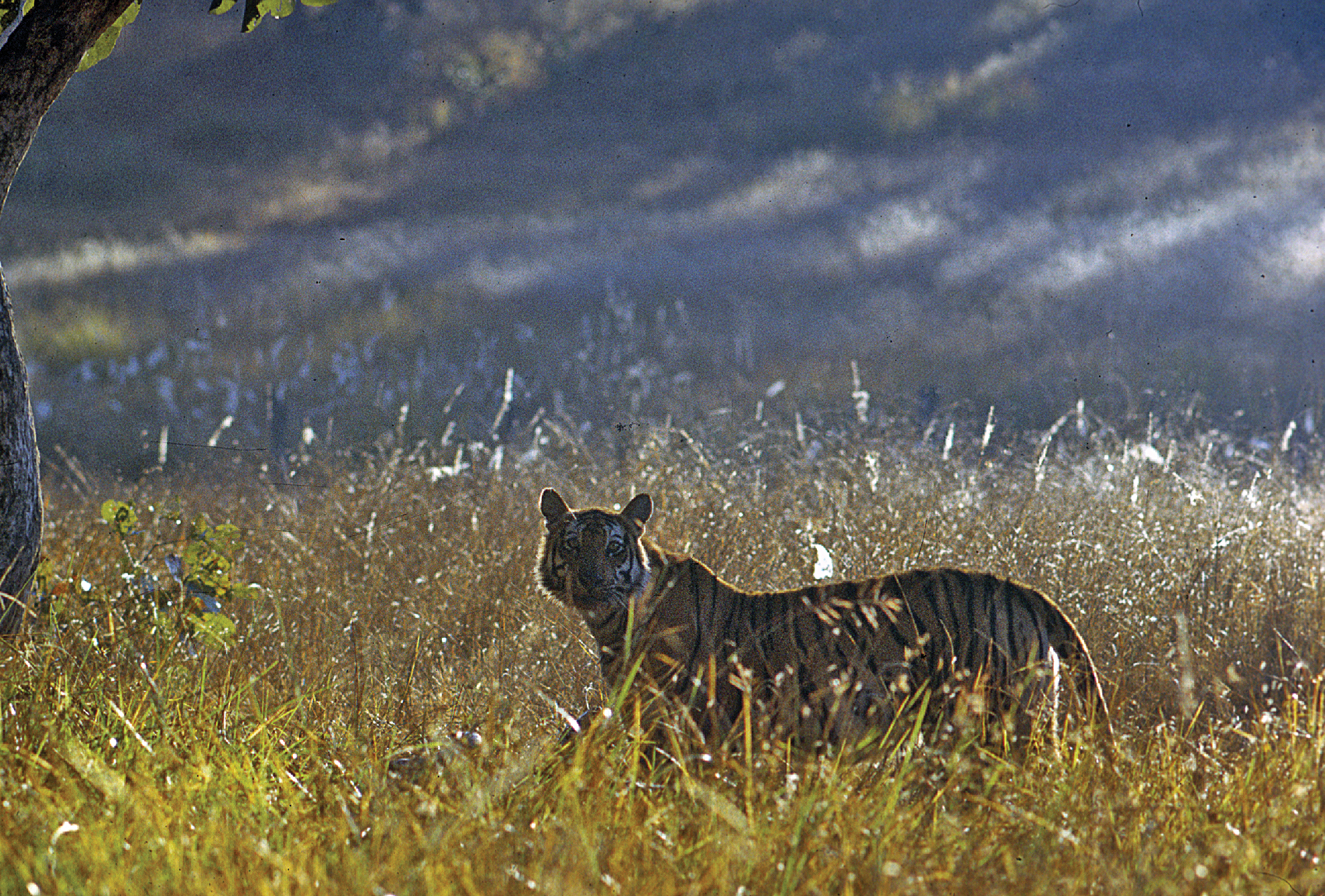
A tigress silhouetted in the Kanha National Park, India back in 1965 when political commitment for the tiger was building, contrary to the situation today. The passage of the controversial Tribal Bill in India, Dr. Schaller asserts, would mean the end of most tiger habitats.
Can you comment on the impact of global warming on the snow leopard? Is there increasing conflict between common leopards and snow leopards as common leopards move higher up the slopes that once were the habitat for snow leopards?
As long as snow leopards have prey higher up, they can get by, and there are already areas where they overlap a bit in the Himalaya. If it comes to real conflict, the snow leopard will lose. We tend to think of snow leopards as living in high mountains, but in Mongolia, they live in low desert ranges. Global warming may not result in those areas becoming forested because theyre too dry, but snow leopards may well find other areas where they can persist away from leopards. Everything is going to be affected by global warming.
Do you have a wish list as to the location of peace parks?
There are well over 150 peace parks in the world, or at least parks on international borders. I'm trying to get Pakistan, Tajikistan, Afghanistan and China to make a peace park in the Pamirs, a magnificent mountain range where the four countries meet. This cross-border region could easily be extended beyond what is currently envisioned. The Pakistan side can extend across the Siachen glacier into India, which has a reserve there already. Peace parks are nice because conservation gets people to talk, even if they don't like each other much. The peace park that I'm working on is mainly for Marco Polo sheep, which have the biggest horns of any sheep, about 1.5 to 1.8 m. long. They're gorgeous animals.
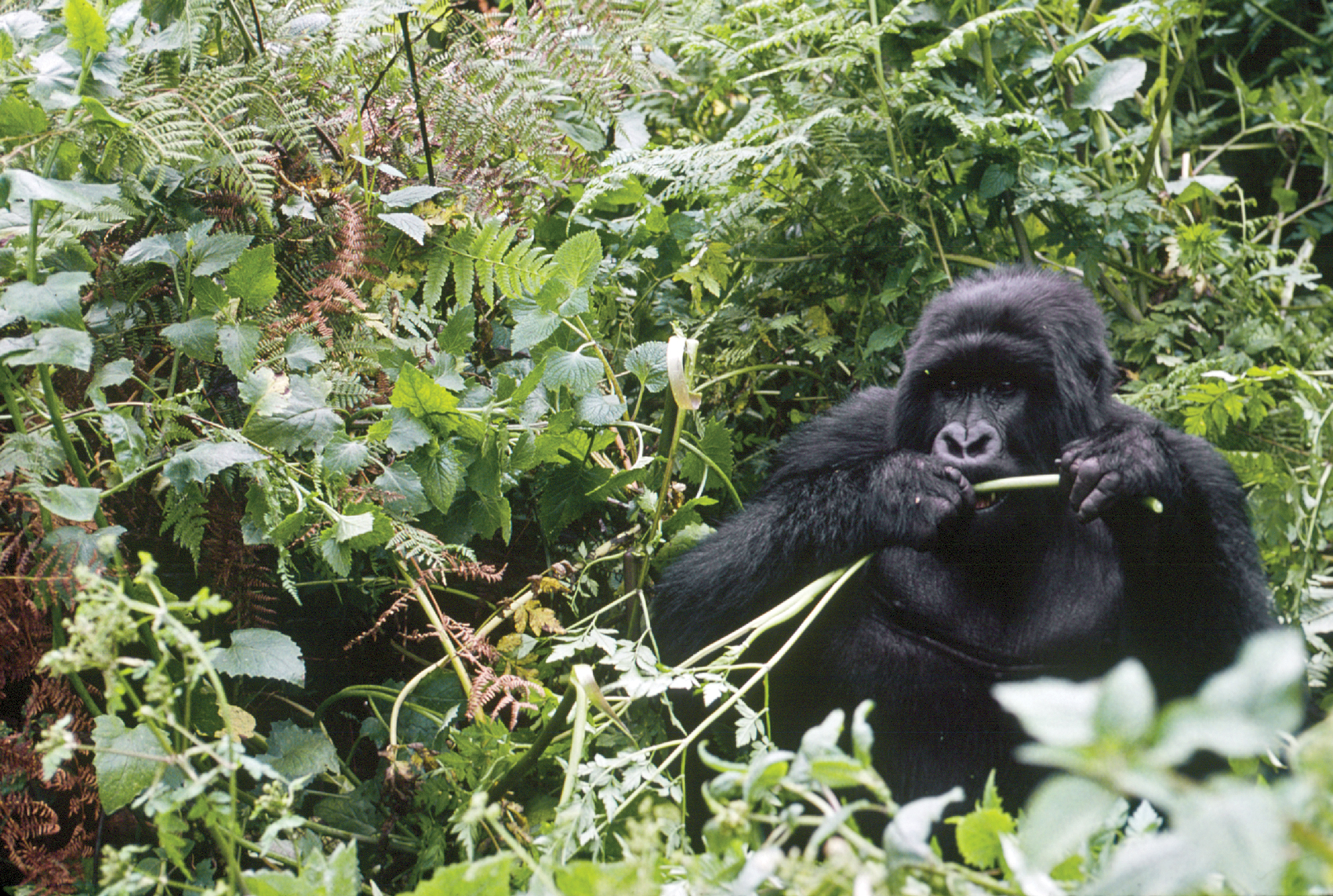
A sub-adult male, mountain gorilla eating wild celery in central Africa, where Dr. Schaller studied the apes in the late 1950s. He revealed to the world that gorillas were far from dangerous “brutes,” and were, in fact, shy creatures that lived in cohesive social groups.
What do you believe to be the purpose of field biology?
If you want to save the environment, and everybody needs the environment to exist, you need information. You can't protect and manage something unless you have basic knowledge about it. Field biologists get the information. How big an area does a tiger use, how much prey does a tiger need to subsist? The answers help you make plans for the habitat and the species. The questions that field biologists now ask have changed somewhat because conservation has become such an imperative. And you've also got to take care of the aspirations and needs of local people.
What is the role of field biology in the 21st century?
Unfortunately, universities teach less and less natural history. Field biology is natural history. Universities are dropping it, saying that we know everything already. We don't know anything yet. There are, maybe, a million and a half species classified, given scientific names. But there are probably a minimum of 50 million species. How do they interact? I don't think well ever really find out how all the species in a rainforest interact. Will the disappearance of some species lead to a cascade of extinctions? We don't begin to know any of that. Field biologists get some information on giant pandas, figure out how many pandas there are in a given area, how much space they need, and then suggest what needs to be protected. That's a good first step, but you actually know very little about the ecology of the area. Even more essential is the need to figure out how to get the public involved. You've got to reach their emotions. You can talk about ethics, about the beauty of animals. The religious community has done far too little. Who speaks up? The Dalai Lama is the only major religious leader speaking up loudly. Every time somebody gets up to preach, they ought to put it in the context of the environment, because the health of the environment affects everybody.
Who should be the prime target of conservationists and field biologists?
Everybody has to get involved, either directly in conservation, or by donating money, becoming an environmental lawyer, or working to ensure that the corporations we work for don't destroy the environment. We're all implicated - each of us has an impact on the environment in every action we take. State governments, federal governments, corporations, local nature groups - through every level of society, we have to take responsibility.
How do you respond to people who maintain that environmentalists want to turn back the clock to force everyone to live in a more primitive fashion and forego luxuries?
Is the average American, who has so much material abundance compared to most of the worlds population, happier now than he or she was 75 years ago when people didn't have so many gadgets? There are a few things like antibiotics that have made a huge impact. But we don't really need all these material things. The waste is horrendous. It's possible to cut down on consumption and still keep a good standard of living.
What do you think the role of the World Bank has been in terms of the environment?
The role of the World Bank is very mixed - some good and some not so good. They make loans to countries, they encourage countries to take loans, and then in order to repay the loans, countries use their land to grow crops for export, instead of for local people. Or they cut timber for export to repay debt. The World Bank has also pushed dams and other projects that have been environmentally very destructive.
Does field biology benefit from more involvement of women?
In many countries, there are probably as many women as men in field biology now. When I hire a field biologist, I don't think in terms of looking for a man or a woman. Though actually, you often get more enthusiasm and strength from a woman in the field than from a man. These days, women seem to be more adventurous than men.
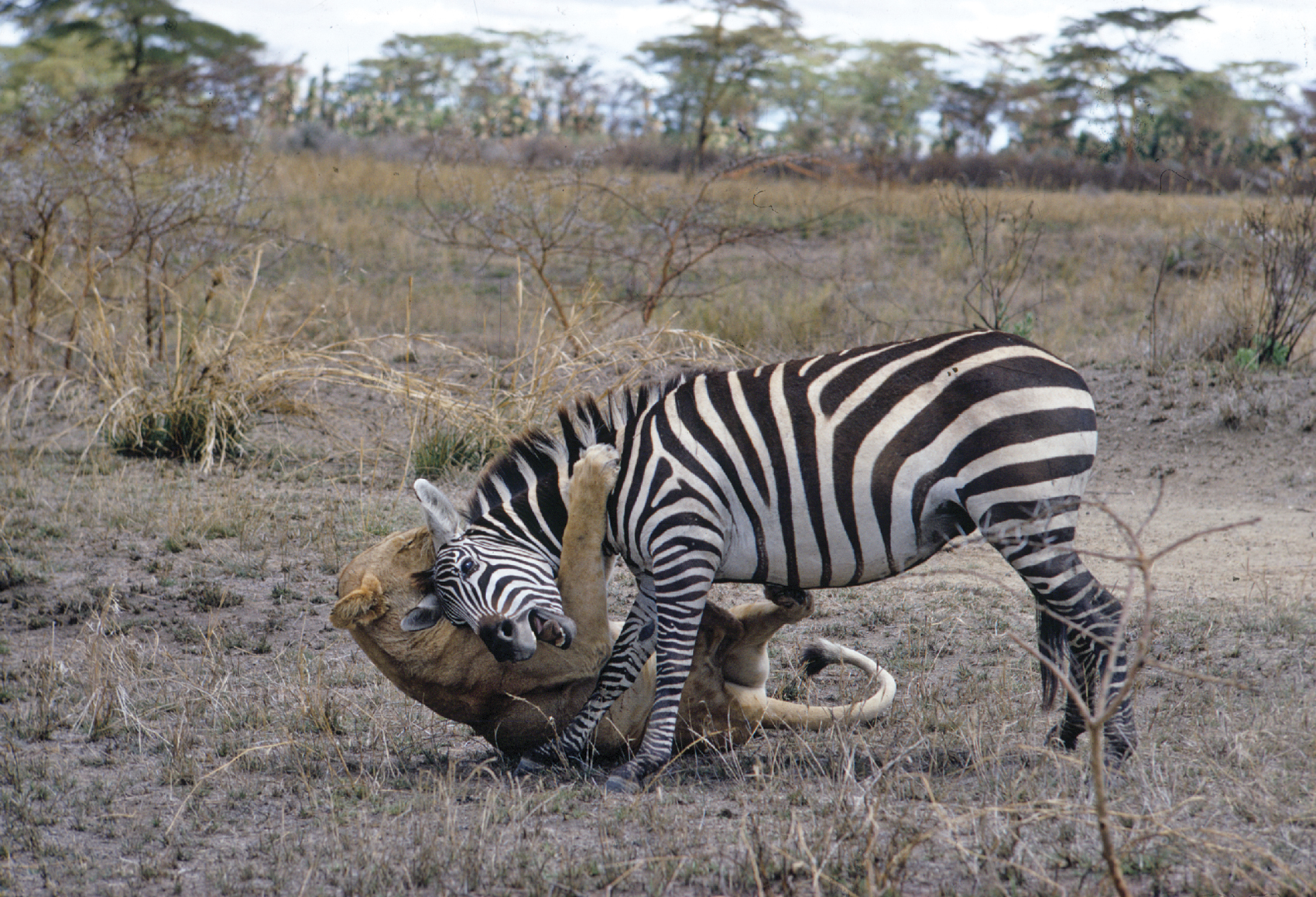
A lioness pulls down a zebra at the Serengeti National Park in Tanzania in 1967, just one of thousands of special moments that Dr. Schaller has recorded in the wild.
Theres a strong emotional component to your work. Can you describe what it was like to see your first tiger or gorilla or panda?
You read all this nonsense about how scientists are not supposed to get emotionally involved in what they do. I couldn't possibly imagine doing good work without being emotionally involved, because in the field, you often live under miserable conditions. Its either very hot or very cold or very wet, and the local people don't know what you're really up to, and your coworkers may not be interested in being miserable. So you're working under conditions where a very strong internal drive is essential to keep the work going. I have different reactions when I see different animals. With gorillas, these are old acquaintances sitting there, and you come to feel you know them. With a tiger, it's a very different feeling. Tigers are probably the most beautiful creatures. But if you meet the tiger on foot, it rather concentrates the mind. You're looking very carefully at its facial expression and so forth, trying to figure out what it's thinking. Different species elicit different responses.
Would you share some of your tiger memories?
I remember coming very close to a tiger that was sleeping on a rock. The poor animal was startled too. I went up a tree, and it sat down below and looked up. If you make a mistake like that, most animals give you the benefit of the doubt. Sometimes they don't, sometimes they eat you! I've never felt seriously threatened, though in retrospect, one realises something could have happened. You try to evaluate things quickly enough to see how you can defuse the situation. Another time I was in a little tree in Kanha on a moonlit night. There were four tigers below, a mother and three nearly full-grown cubs. As I sat watching, a big column of stinging ants came up the tree. Before I knew it, I was covered with them. What to do? There were all these tigers right near by! I took a big leap off the tree and ran like hell to get away. I don't know how the tigers reacted, I didn't stop to find out. They may not have known I was there until I leaped down from the tree. They can smell very well, but they don't use that sense in that way.
Over the span of your career, how has the situation for wildlife improved and worsened?
You never give up hope. You always keep fighting with hope. For so many areas and so many species, you try to focus on something you feel you can accomplish, and you fight for that. When I studied lions in the 60s, they were everywhere. Nobody thought they could be in trouble. There's just been a major meeting to discuss the future of lions because their numbers are dropping so drastically. They're being shot and poisoned because they're around villages, and people are moving into areas that used to be woodlands. We're fighting more and more for just little fragments of nature and little isolated populations, which bring problems in themselves.
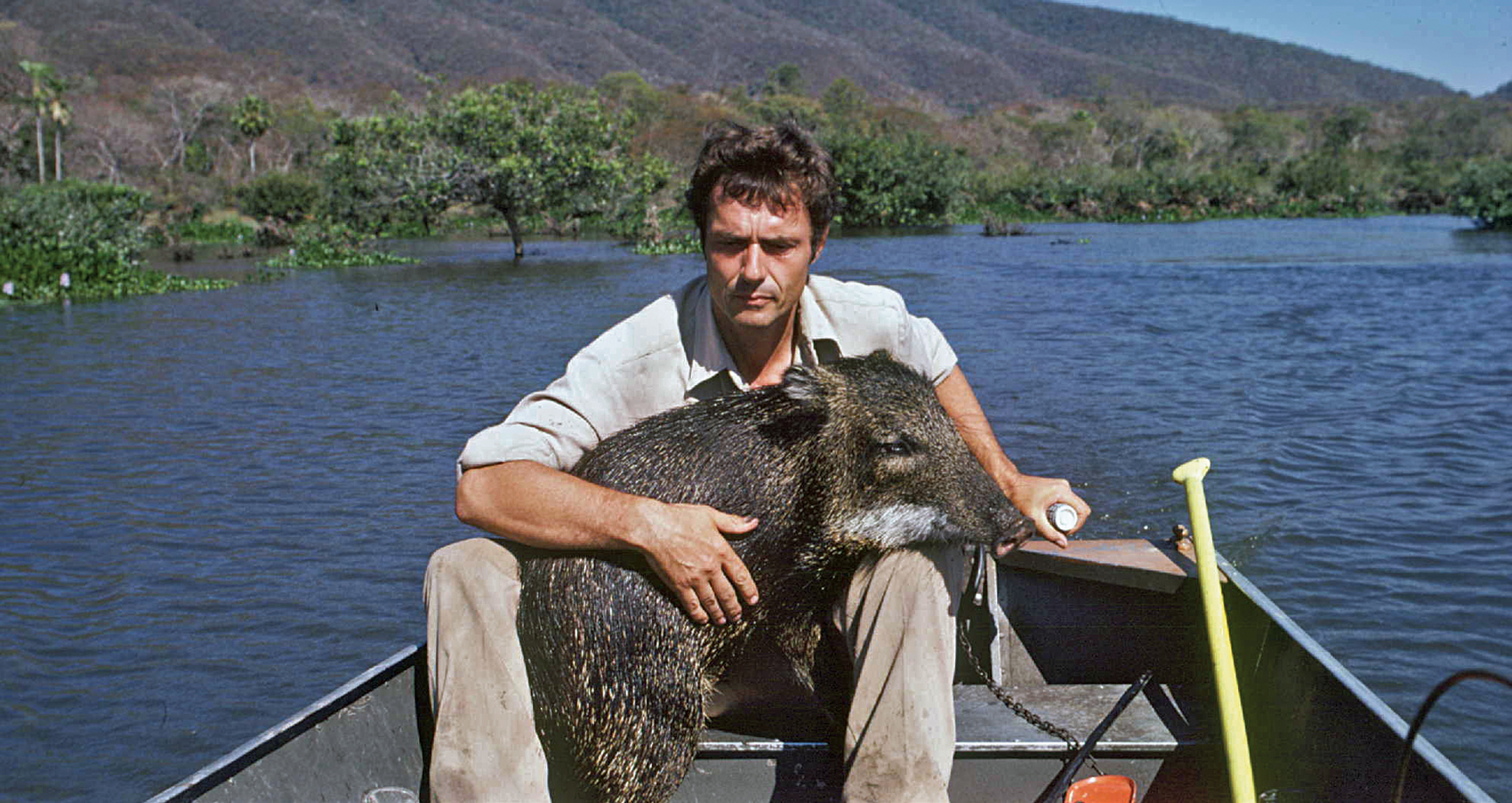
Dr. Schaller with a friend, a white-lipped peccary Tayassu pecari while researching jaguars in the rainforests of Brazil in 1978.
How do you cope with the sadness of this work?
There are so many things you can still do. I'm very lucky to work for the Wildlife Conservation Society. As long as I can find money, I can work where I want. So I pick areas where there's something that intrigues me, something that is remote, something thats not crowded with field biologists, something where I feel I can do something useful. There are a lot of countries that dont really have any field biologists. There are dozens of them in Kenya, so the government doesn't really listen to them. If I go to a country like Tajikistan, the government listens. They may not do what I suggest, but at least I have access. Most people don't enjoy being out in the field. It's not that pleasant often, and they prefer to be in an office. Even in the U.S., most field biologists are within a two-hour drive of a McDonald's! That's very different from being in the middle of nowhere for months.
If you could wave a magic wand, what would you wish for?
I think I would change the human gene, the human mind, so that everybody would wake up in the morning with a land ethic, to be concerned, to love and respect the land they live with. Sanctuary reaches a lot of people, so it has a tremendous impact and is very important in engendering that land ethic. It has interesting articles, excellent photos and it raises awareness on issues people dont normally think about. There has been a wonderful change in India since my first visit in 1963. Back then, there was really no one doing solid field biology. I remember one biologist doing quite a bit of work on rodents. But over the years, India has built a wonderful core of field biologists, one of the best in the world. This is nice to see in a country. They can handle their own situation, they dont need foreigners to go over and show them what to do. In fact, one is lucky to be able to go to India and work with field biologists there.
Sanctuary Asia, VOL. XXVI. No. 4, August 2006.







